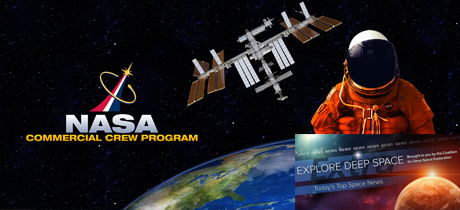In Today’s Deep Space Extra… NASA’s Aerospace Safety Advisory Panel checks efforts by the agency’s Commercial Crew Program to re-establish a U.S. human space launch capability.
Human Space Exploration
Commercial Crew providers making “significant progress” toward first flights
NASAspaceflight.com (6/27): NASA’s Commercial Crew Program partners, Boeing and the CST-100 Starliner and SpaceX and the Crewed Dragon, are progressing toward unpiloted test flights in late 2017 and 2018. Challenges, however, loom as the two companies work to re-establish at U.S. human launch capability that ended with the retirement of NASA’s space shuttle in 2011. Updates on the Commercial Crew program development efforts were presented to NASA’s Aerospace Safety Advisory Panel last month.
Space Science
Farewell, ROSA! Space Station lets go of Roll-Out Solar Array after retraction fail (Video)
Space.com (6/27): Unable to retract an experimental solar array panel, NASA this week was forced to command the release of the hardware from the grasp of an International Space Station robot arm earlier this week. The novel “tape measure” deployment of the Roll-Out Solar Array developed by the U.S. Air Force Research Laboratory and a California based commercial partner unfolded June 18 after the experimental hardware was delivered to the International Space Station in early June as part of the latest NASA contracted commercial re-supply mission. Efforts to roll up ROSA failed earlier this week, prompting a decision to jettison the experiment.
Could a dedicated mission to Enceladus detect microbial life there?
Spaceflight Insider (6/27): Geoffrey Marcy, a pioneering astronomer from the University of California, Berkley, believes a mission to Saturn’s icy moon Enceladus could determine if microbial life is present by flying through a spray erupting from the surface.
Uranus’s magnetic field toggles on and off every day
Cosmos (6/28): Scientists from the Georgia Institute of Technology turned to data gathered by NASA’s Voyager 2 probe as it sped past distant Uranus in 1986 to find a planetary magnetic field much different from the Earth’s. As Uranus turns, the field turns on and off.
Other News
SpaceX’s final Falcon 9 design coming this year, two Falcon Heavy launches next year
Space News (6/27): Space X’s Falcon Heavy launch vehicle is to debut in 2018 with an Arabsat communications satellite as the inaugural customer. The Heavy, however, will launch on a demonstration mission later this year, according to Gywnne Shotwell, SpaceX president and COO, who spoke to a recent industry audience.

